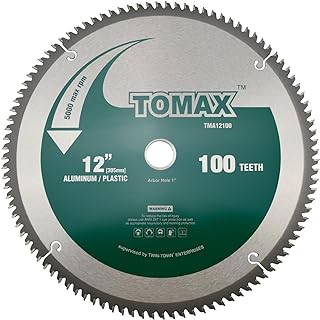Cutting aluminum can be tricky without the right blade, but it doesn’t have to be stressful. If you’re looking for the best saw blade for cutting aluminum, you’ve come to the right place. Many DIYers struggle with uneven cuts or excessive burrs, but the solution often lies in selecting a blade designed specifically for non-ferrous metals.
Here’s the good news: while searching for aluminum-friendly blades, you might also explore options for the best saw blade for cutting plastic, as these blades often share similar tooth geometry that reduces chipping. Experienced woodworkers and metalworkers alike know the value of the best saw blade for aluminum, and investing in the right tool can drastically improve your workflow. Combine this with knowledge of the best saws, and you’re set for clean, precise, and efficient cuts. Let’s dive into the details.
Top Picks
Best Precision: FOXBC 12 Inch Saw Blade for Aluminum Non-Ferrous Metal Cutting, 120T TCG Tooth
The FOXBC 12 Inch Saw Blade delivers exceptional cutting performance for aluminum, copper, and brass with its high-density FoxCarbide construction. Its Triple Chip Grind (TCG) teeth and laser-cut stabilizer vents minimize vibration and noise while ensuring clean, accurate cuts. The -5° hook angle and 120 teeth optimize both speed and precision, making it suitable for a variety of 12-inch miter, slide miter, and table saws.
From a customer and professional standpoint, users appreciate the blade’s longevity and the consistent, burr-free results it provides, especially on thin to medium metal sections. While it comes at a premium price, the enhanced durability and precise cutting make it a reliable choice for both professional workshops and dedicated DIYers seeking efficiency and quality. Overall, the FOXBC 12 Inch saw blade stands out as a high-performance tool that balances durability, precision, and versatility for non-ferrous metal cutting tasks.
Best Longevity: Diablo Saw Blade for Thick Aluminum - 7-1/4" Diameter, 56 TCG Teeth
The Diablo 7-1/4" Saw Blade is engineered for demanding aluminum and non-ferrous metal cutting tasks. Its TiCo Super-Density Micro-Grain Carbide construction ensures long-lasting performance, while the Triple Chip Grind (TCG) teeth deliver smooth, clean cuts. Laser-cut stabilizer vents reduce vibration and noise, improving accuracy and extending blade life. The Perma-SHIELD coating protects against heat, gumming, and corrosion, keeping the blade reliable through repeated use.
From a professional and user perspective, this blade excels in durability and consistency, providing clean cuts even under heavy-duty applications. While priced higher than some alternatives, its combination of longevity, precision, and multi-material capability makes it a valuable tool for contractors and DIYers tackling challenging projects. Overall, the Diablo 7-1/4" saw blade offers dependable performance, making it a top choice for those prioritizing durability and accuracy.
Best Smoothness: 10-Inch 80-Tooth Circular Saw Blade, 5/8-Inch Arbor
The UXACE 10-Inch Circular Saw Blade is crafted for precision cutting of aluminum, plastics, and composite materials. Its hi-density TiCo carbide tips and 75Cr1 hardened steel body ensure durability and consistent performance. The laser-cut thin kerf reduces material waste and energy consumption, while Anti-Vibe Technology minimizes vibration and noise for accurate, stable cuts.
From both professional and user perspectives, this blade stands out for delivering clean, smooth cuts on medium aluminum and non-ferrous metals. Its efficiency and reduced power consumption make it especially suitable for cordless tools, although it is less effective on thicker or ferrous materials. Overall, the UXACE 10-Inch blade offers reliable performance, excellent longevity, and precision for versatile metal and composite cutting tasks.
FAQs
What tooth count for cutting aluminum?
For cutting aluminum, a higher tooth count is generally better because it produces cleaner cuts with less tearing. A blade with 80–120 teeth is ideal for thin sheets, while thicker aluminum (¼ inch or more) may require 40–60 teeth to reduce heat buildup. Carbide-tipped teeth are preferred for durability, and fine-pitch teeth prevent material deformation. Remember: more teeth = smoother cut, but slower feed rate.
Can you cut aluminum with a saw blade?
Yes, you can cut aluminum with a saw blade, but not all blades are suitable. Blades designed for wood or ferrous metals can cause chipping, rough edges, or excessive heat. Look for non-ferrous metal cutting blades or those labeled for aluminum. Carbide-tipped blades with a triple-chip grind (TCG) profile are particularly effective because they stay sharp longer and produce minimal burrs.
What saw do I need to cut aluminum?
The type of saw depends on the aluminum material and your project. Common options include:
-
Miter saws with metal-cutting blades for crosscuts of rods or profiles.
-
Table saws with TCG blades for larger sheets.
-
Circular saws for portable cuts.
-
Band saws for thick aluminum stock or irregular shapes.
Always secure the aluminum with clamps, use slower feed rates, and apply cutting lubricant if needed.
How to cleanly cut aluminum?
To achieve clean cuts in aluminum:
-
Use a blade with the proper tooth count and carbide tips.
-
Secure the workpiece to prevent vibration.
-
Apply cutting oil or lubricant to reduce heat and friction.
-
Use slower feed rates rather than forcing the material.
-
Deburr edges afterward with a file or sandpaper to ensure smooth finishing.
Following these steps prevents rough edges, tearing, and heat damage, giving you professional-quality results.
Conclusion
Choosing the best saw blade for cutting aluminum is crucial for precise, clean, and efficient results. From selecting the right tooth count to using proper cutting techniques, every detail matters. By pairing a quality blade with the correct saw and taking precautions during cutting, you can tackle aluminum projects with confidence. Whether you’re a DIY enthusiast or a professional, the right blade ensures smooth cuts, minimal burrs, and longer-lasting tools.






















